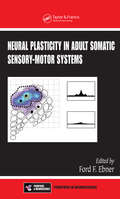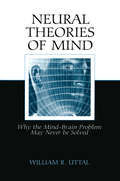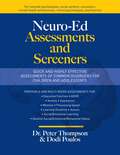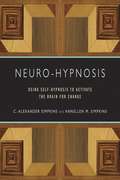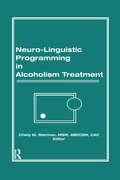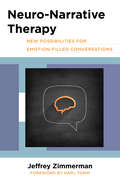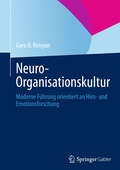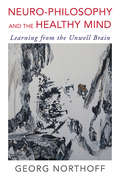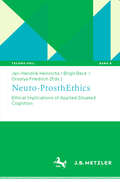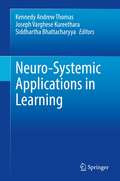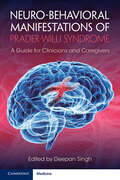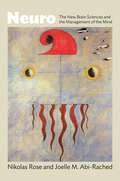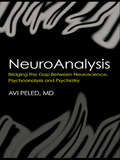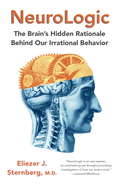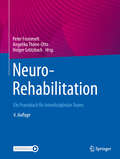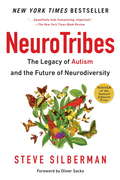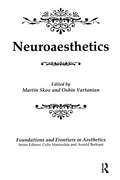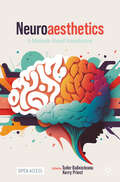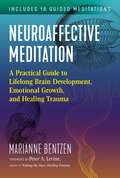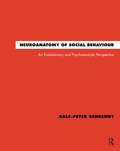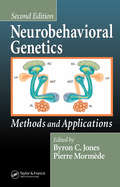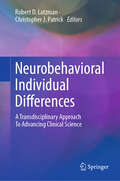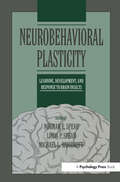- Table View
- List View
Neural Plasticity in Adult Somatic Sensory-Motor Systems (Frontiers in Neuroscience)
by Ford F EbnerSynthesizing current information about sensory-motor plasticity, Neural Plasticity in Adult Somatic Sensory-Motor Systems provides an up-to-date description of the dynamic processes that occur in somatic sensory-motor cortical circuits or somatic sensory pathways to the cortex due to experience, learning, or damage to the nervous system. The book e
Neural Theories of Mind: Why the Mind-Brain Problem May Never Be Solved
by William R. UttalIn this fascinating book, William R. Uttal raises the possibility that, however much we learn about the anatomy and physiology of the brain and psychology, we may never be able to cross the final bridge explaining how the mind is produced by the brain. Three main classes of mind-brain theory are considered and rejected: field theories, because they are based on a superficial analogy; single cell theories, because they emerge from a massive uncontrolled experimental program; and neural net theories, because they are constrained by combinatorial complexity.To support his argument, Uttal explores the empirical and conceptual foundations of these theoretical approaches and identifies flaws in their fundamental logic. The author concludes that the problems preventing solution of the mind-brain problem are intractable, yet well within the confines of natural science.
Neuro-/Psychopharmaka im Kindes- und Jugendalter: Grundlagen und Therapie
by Manfred Gerlach Claudia Mehler-Wex Susanne Walitza Christoph Wewetzer Marcel RomanosDas Buch vermittelt aktuell und umfassend das Wissen auf dem Gebiet der Neuro-/Psychopharmakologie. Um ein tieferes Verständnis der Therapieprinzipien sowie der Besonderheiten der medikamentösen Behandlung bei Kindern und Jugendlichen zu erhalten, werden im ersten Teil die Grundlagen der Neuro-/Psychopharmakologie dargelegt. Zudem werden rechtliche und ethische Fragen im Praxisalltag eingehend erörtert. Der zweite Teil behandelt ausführlich die verschiedenen Arzneistoffgruppen. Im dritten Teil wird die störungsspezifische und symptomorientierte Medikation praxisorientiert beschrieben und kritisch bewertet, so dass der Arzt über eine klare Handlungsanleitung verfügt. Die vierte Auflage wurde aktualisiert und auf den neusten wissenschaftlichen Stand gebracht. Dieses Nachschlagewerk besticht durch die komprimierte und einheitliche Darstellung mit vielen zweifarbigen Tabellen, Schemata und Abbildungen. Es wendet sich an Kinder- und Jugendpsychiater und -psychotherapeuten, Pädiater, Allgemeinmediziner, Psychologen, Pflegekräfte und Lehrer.
Neuro-Ed Assessments and Screeners: Quick and Highly Effective Assessments of Common Disorders for Children and Adolescents
by Peter Thompson Dodi PoulosNeuro-Ed Assessment and Screeners are fast and effective assessment forms for busy mental health and educational professionals. These practical assessments were created by practitioners who know the needs of professionals working in the field. Th
Neuro-Hypnosis: Using Self-Hypnosis to Activate the Brain for Change
by C. Alexander Simpkins Annellen M. SimpkinsUnderstanding the neuroscience of self-hypnosis for more effective treatment of a variety of conditions. Drawing from over 30 years of teaching, researching, and practicing hypnosis, the authors share systematic instructions, techniques, and exercises for finding your way into a hypnotic trance--or deepen your trance if you've already found it. With exercises specifically tailored to address a wide range of concerns, including stress, depression, substance abuse, anxiety, weight management, fears, and sports performance, this book is a comprehensive guide for anyone interested in hypnosis. The authors synthesize and integrate the major theories of hypnosis and provide an overview of the fundamental tools used in self-hypnosis, especially attention, unconscious processing, and suggestion. For clinicians, they provide evidence and practical considerations that therapists need to incorporate hypnosis into their practice. All readers will benefit from the tips, techniques, and exercises throughout which demonstrate how hypnotic interventions can be tailored to each person. Readers will be inspired to practice at home using hypnotic suggestions that target their specific concerns. Deftly balancing theory and practice, Neuro-Hypnosis provides the tools you need to open yourself to self-hypnosis, experience the vast potential of your mind, and activate your brain for growth, development, and lasting change.
Neuro-Linguistic Programming in Alcoholism Treatment
by Bruce Carruth Chelly M StermanHere is a practical and clearly written guide to the use of Neuro-Linguistic Programming in the treatment of alcoholism and other addictions. This comprehensive volume illustrates how the focus of Neuro-Linguistic Programming (NLP) on the individual and the family increases the effectiveness of counseling by targeting the uniqueness of each individual and his or her family system. Professionals will also learn how NLP facilitates effective interventions and helps alcoholics create internal coping skills to begin and maintain the recovery process. Neuro-Linguistic Programming in Alcoholism Treatment is a wealth of innovative, state-of-the-art information on the history of NLP, basic NLP assumptions, concepts for establishing rapport with clients, and essential family participation in NLP.Each chapter directs itself either to a specific NLP technique, featuring clear case demonstrations and a step-by-step outline for applying the technique to the development of the counseling process in working with addicted systems, or to a particular group affected by addiction, such as alcoholics, children of alcoholics, or the addicted family as a unit. Clinicians focus on alcoholism and other addictions as treatable conditions, applying specific strategies and techniques--initially developed in Neuro-Linguistic Programming and Hypnotherapy--adapted to meet the demands of alcoholism and addiction treatment specialists. This important volume allows for a substantial increase in the repertoire of treatment choices available to professionals and enables clinicians to individualize treatment. An extensive bibliography is included to further assist readers in gaining additional skills in the treatment of alcoholics and other addicts.
Neuro-Narrative Therapy: New Possibilities For Emotion-filled Conversations
by Jeffrey ZimmermanBringing interpersonal neurobiology and narrative therapy together. Narrative therapy understands storytelling as the way we make sense of ourselves and life experience. Many non-narrative therapists have expressed great admiration and interests in the politics the work exposes, the way it brings in the socio-political context, and the way it centers clients. Yet despite its popularity and success as a useful therapeutic approach, Narrative Therapy has been criticized as minimizing and failing to develop any extended discussion of something vital to our lives: emotion. Neuro-Narrative Therapy attempts to redress this problem by taking us first through standard Narrative practices, and then showing how and where affect can be brought in and even privileged in the work. After situating the evolution of Narrative Therapy in its historical context, the book provides information about why emotions should be given an important place in the work. Specifically, it brings ideas and implications of some of the most exciting and novel theories—interpersonal neurobiology and affective neuroscience—to the practice of Narrative Therapy. Readers will learn about the growing emphasis on the right brain, and how an understanding of the ways in which emotion and affect are manifested by the brain can help us help our clients. The possibilities for this new approach are many: a freer discussion of the emotional side of your clients; an understanding and sensitivity to the relation of body and mind; attention to how the therapeutic relationship of our clients can become a resource in treatment and a renewed understanding of how our memories—and thus our stories about our lives—develop in early childhood and beyond. For any therapist working in the area of Narrative Therapy, and for any interested in the emerging understandings that science is bringing to appreciating how our brains develop with and among each other, this book has something to offer. Combining the neuro- and the narrative, as Jeffrey Zimmerman has done here, will create a new direction in Narrative Therapy, one in which our brain and body work together, inviting a more direct and effective engagement with clients.
Neuro-Organisationskultur: Moderne Führung orientiert an Hirn- und Emotionsforschung
by Garo D. Reisyan"Neuro-Organisationskultur" oder kurz "Neurokultur" baut auf die Erfahrungen auf, die in den letzten 30 Jahren mit Organisationskultur gemacht wurden und ergänzt sie um neueste Erkenntnisse aus Hirn- und Emotionsforschung sowie um wichtige Einsichten aus Soziologie und Psychologie. Die aktuelle Konzeptlandschaft zum Thema Organisationskultur ist im Kern 20-30 Jahre alt und weist für praktische Operationalisierungen gravierende Unzulänglichkeiten auf. Mit dem Konzept "Neurokultur" wird ein neuartiges Kulturmodell vorgestellt, das im Kern die drei Bausteine Reflexivität, Vorstellungen und Emotionen aufweist. Dazu führt der Autor in die neurowissenschaftlichen Grundlagen z. B. von Wahrnehmung, Gedächtnis und Lernen ein und macht mit Konstrukten, wie etwa Emotion, Stress, kognitiver Dissonanz, Intelligenz, Aufmerksamkeit und Kreativität vertraut. Neuartig ist auch, dass Gruppen und Individuen konsistent unter einem Dach konzeptualisiert wurden. Insgesamt ergibt sich ein signifikant belastbareres Verständnis von kulturellen Phänomenen und menschlichem Verhalten, wodurch sich neue Möglichkeiten der Operationalisierung eröffnen. Dazu wird ein struktureller Rahmen nebst Begriffsinventar sowie konkrete Methoden und Vorlagen zur Analyse, kontinuierlichen Pflege und gezielten Veränderung von Organisationskultur dargeboten. Schließlich werden wichtige Megatrends skizziert, auf deren Basis Anforderungen an das kulturelle Profil von Organisationen des 21. Jahrhunderts abgeleitet werden. Das praxisorientierte Buch enthält zahlreiche Beispiele aus Unternehmen und Exkurse zu aktuellen Themen aus Gesellschaft, Politik und allgemeiner Lebensführung.
Neuro-Philosophy and the Healthy Mind: Learning from the Unwell Brain
by Georg NorthoffApplying insights from neuroscience to philosophical questions about the self, consciousness, and the healthy mind. Can we “see” or “find” consciousness in the brain? How can we create working definitions of consciousness and subjectivity, informed by what contemporary research and technology have taught us about how the brain works? How do neuronal processes in the brain relate to our experience of a personal identity? Where does the brain end and the mind begin? To explore these and other questions, esteemed philosopher and neuroscientist Georg Northoff turns to examples of unhealthy minds. By investigating consciousness through its absence—in people in vegetative states, for example—we can develop a model for understanding its presence in an active, healthy person. By examining instances of distorted self-recognition in people with psychiatric disorders, like schizophrenia, we can begin to understand how the experience of “self” is established in a stable brain. Taking an integrative approach to understanding the self, consciousness, and what it means to be mentally healthy, this book brings insights from neuroscience to bear on philosophical questions. Readers will find a science-grounded examination of the human condition with far-reaching implications for psychology, medicine, our daily lives, and beyond.
Neuro-ProsthEthics: Ethical Implications of Applied Situated Cognition (Techno:Phil – Aktuelle Herausforderungen der Technikphilosophie #9)
by Jan-Hendrik Heinrichs Birgit Beck Orsolya FriedrichThe volume focusses on the ethical dimensions of the technological scaffold embedding human thought and action, which has been brought to attention of the cognitive sciences by situated cognition theories. There is a broad spectrum of technologies co-realising or enabling and enhancing human cognition and action, which vary in the degree of bodily integration, interactivity, adaptation processes, of reliance and indispensability etc. This technological scaffold of human cognition and action evolves rapidly. Some changes are continuous, some are eruptive. Technologies that use machine learning e.g. could represent a qualitative leap in the technological scaffolding of human cognition and actions. The ethical consequences of applying situated cognition theories to practical cases had yet to find adequate attention and are elucidated in this volume.
Neuro-Systemic Applications in Learning
by Siddhartha Bhattacharyya Joseph Varghese Kureethara Kennedy Andrew ThomasNeuroscience research deals with the physiology, biochemistry, anatomy and molecular biology of neurons and neural circuits and especially their association with behavior and learning. Of late, neuroscience research is playing a pivotal role in industry, science writing, government program management, science advocacy, and education. In the process of learning as experiencing knowledge, the human brain plays a vital role as the central governing system to map the images of learning in the human brain which may be called educational neuroscience. It provides means to develop a common language and bridge the gulf between educators, psychologists and neuroscientists. The emerging field of educational neuroscience presents opportunities as well as challenges for education, especially when it comes to assess the learning disorders and learning intentions of the students. The most effective learning involves recruiting multiple regions of the brain for the learning task. These regions are associated with such functions as memory, the various senses, volitional control, and higher levels of cognitive functioning. By considering biological factors, research has advanced the understanding of specific learning difficulties, such as dyslexia and dyscalculia. Likewise, neuroscience is uncovering why certain types of learning are more rewarding than others. Of late, a lot of research has gone in the field of neural networks and deep learning. It is worthwhile to consider these research areas in investigating the interplay between the human brain and human formal/natural learning. This book is intended to bring together the recent advances in neuroscience research and their influence on the evolving learning systems with special emphasis on the evolution of a learner-centric framework in outcome based education by taking into cognizance the learning abilities and intentions of the learners.
Neuro-behavioral Manifestations of Prader-Willi Syndrome: A Guide for Clinicians and Caregivers
by Deepan SinghThe behavioral issues experienced by individuals with Prader-Willi Syndrome (PWS) can be both surprising and overwhelming to clinicians and caregivers. Despite the distress and dysfunction posed by them, there are very few resources available to address these neuropsychiatric problems. This invaluable guidebook helps to identify and address the spectrum of behavioral issues faced by individuals with PWS. Written by a psychiatrist with unique expertise in the management of patients with this condition, this easy-to-read book explores practical details that will aid any clinician or caregiver. Chapters offer vivid case examples and clear guidance on both the behavioral and pharmacological management of issues such as anxiety, skin-picking, ADHD, disruptive behavior (including non-suicidal self-harm), mood disorders (including depression and bipolar disorder), and psychosis. Neuro-behavioral Manifestations of Prader-Willi Syndrome serves as an essential and practical companion for any caregiver or healthcare professional providing care to people with PWS.
Neuro: The New Brain Sciences and the Management of the Mind
by Nikolas Rose Joelle M. Abi-RachedHow the new brain sciences are transforming our understanding of what it means to be humanThe brain sciences are influencing our understanding of human behavior as never before, from neuropsychiatry and neuroeconomics to neurotheology and neuroaesthetics. Many now believe that the brain is what makes us human, and it seems that neuroscientists are poised to become the new experts in the management of human conduct. Neuro describes the key developments—theoretical, technological, economic, and biopolitical—that have enabled the neurosciences to gain such traction outside the laboratory. It explores the ways neurobiological conceptions of personhood are influencing everything from child rearing to criminal justice, and are transforming the ways we "know ourselves" as human beings. In this emerging neuro-ontology, we are not "determined" by our neurobiology: on the contrary, it appears that we can and should seek to improve ourselves by understanding and acting on our brains.Neuro examines the implications of this emerging trend, weighing the promises against the perils, and evaluating some widely held concerns about a neurobiological "colonization" of the social and human sciences. Despite identifying many exaggerated claims and premature promises, Neuro argues that the openness provided by the new styles of thought taking shape in neuroscience, with its contemporary conceptions of the neuromolecular, plastic, and social brain, could make possible a new and productive engagement between the social and brain sciences.Copyright note: Reproduction, including downloading of Joan Miro works is prohibited by copyright laws and international conventions without the express written permission of Artists Rights Society (ARS), New York.
NeuroAnalysis: Bridging the Gap between Neuroscience, Psychoanalysis and Psychiatry
by Avi PeledNeuroAnalysis investigates using the neural network and neural computation models to bridge the divide between psychology, psychoanalysis, and neuroscience when diagnosing mental health disorders and prescribing treatment. Avi Peled builds on Freud's early attempts to explain the neural basis of mental health by introducing neural computation as a bridging science to explain psychiatric disorders. Peled describes the brain as a complex system of interconnected units and goes on to suggest that conscious experience, feelings, and mood are emergent properties arising from these complex organisations. This model describes mental health disorders in terms of perturbation to the optimal brain organisation, and demonstrates how particular disorders can be identified through a specific breakdown pattern of the brain’s organisation. This fresh approach to the diagnosis of psychiatric disorders will interest students, professors, and researchers of psychoanalysis, neuroscience, and their related fields.
NeuroLogic
by Eliezer SternbergA groundbreaking investigation of the brain's hidden logic behind our strangest behaviors, and of how conscious and unconscious systems interact in order to create our experience and preserve our sense of self. From bizarre dreams and hallucinations to schizophrenia and multiple personalities, the human brain is responsible for a diverse spectrum of strange thoughts and behaviors. When observed from the outside, these phenomena are often written off as being just "crazy," but what if they were actually planned and logical? NeuroLogic explores the brain's internal system of reasoning, from its unconscious depths to conscious decision making, and illuminates how it explains our most outlandish as well as our most stereotyped behaviors. From sleepwalking murderers, contagious yawning, and the brains of sports fans to false memories, subliminal messages, and the secret of ticklishness, Dr. Eliezer Sternberg shows that there are patterns to the way the brain interprets the world---patterns that fit the brain's unique logic. Unraveling these patterns and the various ways they can be disturbed will not only alter our view of mental illness and supernatural experience, but will also shed light on the hidden parts of ourselves. (With black-and-white illustrations throughout.)From the Hardcover edition.
NeuroLogic: The Brain's Hidden Rationale Behind Our Irrational Behavior
by Eliezer SternbergA groundbreaking investigation of the brain's hidden logic behind our strangest behaviors, and of how conscious and unconscious systems interact in order to create our experience and preserve our sense of self. From bizarre dreams and hallucinations to schizophrenia and multiple personalities, the human brain is responsible for a diverse spectrum of strange thoughts and behaviors. When observed from the outside, these phenomena are often written off as being just "crazy," but what if they were actually planned and logical? NeuroLogic explores the brain's internal system of reasoning, from its unconscious depths to conscious decision making, and illuminates how it explains our most outlandish as well as our most stereotyped behaviors. From sleepwalking murderers, contagious yawning, and the brains of sports fans to false memories, subliminal messages, and the secret of ticklishness, Dr. Eliezer Sternberg shows that there are patterns to the way the brain interprets the world---patterns that fit the brain's unique logic. Unraveling these patterns and the various ways they can be disturbed will not only alter our view of mental illness and supernatural experience, but will also shed light on the hidden parts of ourselves. (With black-and-white illustrations throughout.)From the Hardcover edition.
NeuroRehabilitation: Ein Praxisbuch für interdisziplinäre Teams
by Holger Grötzbach Peter Frommelt Angelika Thöne-OttoDas Praxisbuch der Neurorehabilitation…… komplett aktualisiert und überarbeitet: Das große Praxisbuch bietet Grundlagen- und Praxiswissen, detailliert, kritisch, verständlich und an den Bedürfnissen der Patienten orientiert – ein rundum alltagstaugliches Arbeitsbuch für Teams, ein Lehrbuch für die Aus- und Weiterbildung. Mit neuen Kapiteln u.a. zu Telerehabilitation und der Umsetzung spezieller Therapieformen wie Virtual Reality, musikgestützte Therapie, Natur und Tiere.Umfassend: Mit ausführlicher Darstellung der Grundlagen und der Tätigkeitsfelder, beginnend von der Behandlung auf der Stroke Unit bis hin zur Rückkehr in Familie und Beruf.Interdisziplinär: Die gemeinsame Ausbildungs – und Arbeitsgrundlage für alle Berufsgruppen, die in interdisziplinären Teams zusammenarbeiten: Ärzte, Pflegekräfte, Physiotherapeuten, Ergotherapeuten, Logopäden, Neuropsychologen, Sozialpädagogen, Musiktherapeuten u.a.Aktuell: Wissenschaftlich, evidenzbasiert, durchgängig mit bio-psycho-sozialer Orientierung und von den Prinzipien der ICF (Internationale Klassifikation der Funktionsfähigkeit, Behinderung und Gesundheit) geleitet.Kompetent: Fundiertes Fachwissen aus langjähriger Erfahrung, vermittelt von über 50 renommierten internationalen Autoren (aus Deutschland, Schweiz, Großbritannien, Finnland, USA).Informativ: Auch mit Reflexionen über Themen wie „Kontextsensitive Neurorehabilitation“ „Teamarbeit und Zielsetzung“, „Sexualität“, „ Identität und Biografie“, „Holistische neuropsychologische Rehabilitation“.Leserfreundlich: Leicht zugänglich mitEinheitlicher Aufbau der Kapiteloptischer Textstrukturierung: mit Trailers, Praxistipps, Übersichtsboxen, Exkursen („Näher betrachtet“) und mehr…
NeuroTribes
by Steve SilbermanA groundbreaking book that upends conventional thinking about autism and suggests a broader model for acceptance, understanding, and full participation in society for people who think differently. What is autism? A lifelong disability, or a naturally occurring form of cognitive difference akin to certain forms of genius? In truth, it is all of these things and more--and the future of our society depends on our understanding it. WIRED reporter Steve Silberman unearths the secret history of autism, long suppressed by the same clinicians who became famous for discovering it, and finds surprising answers to the crucial question of why the number of diagnoses has soared in recent years. Going back to the earliest days of autism research and chronicling the brave and lonely journey of autistic people and their families through the decades, Silberman provides long-sought solutions to the autism puzzle, while mapping out a path for our society toward a more humane world in which people with learning differences and those who love them have access to the resources they need to live happier, healthier, more secure, and more meaningful lives. Along the way, he reveals the untold story of Hans Asperger, the father of Asperger's syndrome, whose "little professors" were targeted by the darkest social-engineering experiment in human history; exposes the covert campaign by child psychiatrist Leo Kanner to suppress knowledge of the autism spectrum for fifty years; and casts light on the growing movement of "neurodiversity" activists seeking respect, support, technological innovation, accommodations in the workplace and in education, and the right to self-determination for those with cognitive differences.From the Hardcover edition.
Neuroaesthetics (Foundations and Frontiers in Aesthetics Series)
by Oshin Vartanian Arnold Berleant Martin Skov Colin MartindaleThe beginning of psychological aesthetics is normally traced back to the publication of Gustav Theodor Fechner's seminal book "Vorschule der Aesthetik" in 1876. Following in the footsteps of this rich tradition, editors Martin Skov and Oshin Vartanian view neuroaesthetics - the emerging field of inquiry concerned with uncovering the ways in which aesthetic behavior is caused by brain processes - as a natural extension of Fechner's 'empirical spirit' to understand the link between the objective and subjective worlds inherent in aesthetic experience. The editors had two specific aims for this book. The first was to highlight the diversity of approaches that are underway under the banner of neuroaesthetics.Currently, this topic is being investigated from experimental, evolutionary, neuropsychological, and neuroimaging perspectives to tackle problems in the visual arts, literature, music, and film. Its quintessentially interdisciplinary nature has functioned as a breeding ground for generating and testing hypotheses in multiple domains. The second goal was more integrative and involved distilling some of the key features common to these diverse strands of work. The book presents a possible framework for neuroaesthetics by highlighting what the contributors consider to be its defining features and offering a working definition of neuroaesthetics that captures these features. "Neuroaesthetics" will provide an empirical and theoretical framework to motivate further work in this area. Ultimately, the hope is that puzzles in aesthetics can be solved through insights from biology, but that the contribution can be truly bidirectional.
Neuroaesthetics: A Methods-Based Introduction
by Tudor Balinisteanu Kerry PriestThis open access neuroaesthetics textbook, the first in the world, is designed for teaching a semester module (14 meetings) to undergraduate/masters students from both the sciences and the humanities. Written in a style that appeals to humanities students without prior science training, and to science students without prior humanities training, the textbook contains 6 Units, material for an introductory class, and summative comments to be discussed in a closing meeting. Each Unit comprises an overview designed as student home reading, a lecture, and a lab. The labs contain detailed step-by-step instructions for running a basic experiment and analysing the collected data, that can be easily implemented in humanities and science departments alike. The textbook introduces students to philosophical considerations of neuroaesthetics topics in context of the history of empirical aesthetics, showcases experimental approaches to the empirical study of dance, the visual arts, and music, and supports hands-on training in experimental research methods.
Neuroaffective Meditation: A Practical Guide to Lifelong Brain Development, Emotional Growth, and Healing Trauma
by Marianne Bentzen• Shares 16 guided meditations for neuroaffective brain development and emotional maturation, along with links to online recordings • Explores the stages of emotional development, from childhood to old age, and their potentials for developing new ways of functioning • Reveals the biopsychological effects of meditation on the human brain, including how it affects us at the autonomic, limbic, and prefrontal levels Drawing on her 25 years of research into brain development as well as decades of meditation practice, psychotherapist Marianne Bentzen shows how neuroaffective meditation--the holistic integration of meditation, neuroscience, and psychology--can be used for personal growth and conscious maturation. She also explores how the practice can help address embedded traumas and allow access to the best perspectives of growing older while keeping the best psychological attitudes of being young--a hallmark of wisdom. She explains that there is a sequence to emotional maturation, just as there is for the development of cognitive or athletic skills, and details the central developmental processes of childhood and adolescence and the adult stages of psychological development. She then explores the biopsychological effects of meditation on the human brain, including how it affects us at the autonomic, limbic, and prefrontal levels. The author shares 16 guided meditations for neuroaffective brain development (along with links to online recordings), each designed to gently interact with the deep, unconscious layers of the brain and help you reconnect to yourself, your relationships, and the world around. Each meditation explores a different theme, from breathing in &“being in your body&” to feeling love, compassion, and gratitude in &“the songs of the heart&” to balancing positive and negative experiences in &“mandala.&” The author also shares a 5-part meditation centered on breathing exercises designed to balance your energy. Presenting an authentic, stepwise approach to spiritual growth, emotional maturation, and brain development, this guide explains the science behind neuroaffective meditation and offers detailed practices for a truly personal and ever-evolving experience of inner wisdom and growth.
Neuroanatomy of Social Behaviour: An Evolutionary and Psychoanalytic Perspective
by Ralf-Peter BehrendtThis book is for readers who are knowledgeable about the neurosciences and curious about brain mechanisms that produce normal and pathological social behaviour. It is a reference work that presents and reviews facts and recent findings that need to be accounted for within a coherent neuroanatomy and neurophysiology of social behaviour.
Neurobehavioral Genetics: Methods and Applications, Second Edition
by Byron C. Jones D. V. M. Pierre MormèdeA complete background to concepts and principles of behavioral genetics, Neurobehavioral Genetics: Methods and Applications, Second Edition features a broad spectrum of the most current techniques in neurobehavioral genetics in a single source. International researchers incorporate several new developments in the field, including:De
Neurobehavioral Individual Differences: A Transdisciplinary Approach To Advancing Clinical Science
by Christopher J. Patrick Robert D. LatzmanThis is the first book of its kind to bring together a diverse set of human and nonhuman animal researchers to explore neurobehavioral trait dimensions with optimal relevance to mental illness: threat sensitivity, reward sensitivity, inhibitory control, affiliative capacity, and schizotypy. The volume presents foundational material, methodological considerations, and the integration of animal and human studies, providing a careful investigation of neurobehavioral trait dimensions. A special feature is the inclusion of paired chapters contrasting animal and human studies that demonstrate the state of the field. It also discusses the most promising neurobehavioral trait dimensions for understanding the processes associated with human mental illness. This integrated perspective fosters a deeper understanding of how individual differences in neurobiology contribute to the diversity of human behavior and the complex nature of mental health disorders. Taken together, insights into neurobehavioral traits promise to catalyze new research directions, inform policy decisions, and ultimately improve outcomes for individuals grappling with mental illness.
Neurobehavioral Plasticity: Learning, Development, and Response to Brain Insults
by Robert L. IsaacsonThis book describes a unique combination of research programs based on a striking variety of hypotheses and procedures directed toward understanding the sources and consequences of neurobehavioral plasticity. This remarkable attribute of the nervous system -- to be pliable and capable of being shaped or formed by natural or artificial sources toward adaptation or maladaptation -- is considered in terms of the neurochemical forces and neuroanatomical structure that has been found to be pivotal for this function. The impetus for this volume was a symposium held to honor Robert L. Isaacson for his scientific and pedagogical achievements as well as his contributions to behavioral neuroscience. Corresponding to his three major research interests, the book is divided into three sections as follows: * the first explores the relationship between the limbic system and behavior, with an emphasis on learning and memory; * the second considers -- through a wide range of approaches -- issues of plasticity in behavior and brain; and * the third deals with neural and chemical determinants of normal and abnormal behavior. This volume is not only a fitting tribute to Isaacson, but also an unusual collection of new evidence, procedures, and theories destined to have significant influence on behavioral neuroscience.
